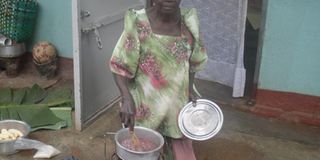The 70-year-old who makes charcoal out of garbage

Joyce Nansamba cooks beans on garbage charcoal. To save money and conserve trees, she makes charcoal out of rubbish and soil. Photo By Emma Ikwap
What you need to know:
As you throw out your rubbish, Joyce Nansamba jealously guards hers and even grabs yours because it will give her free charcoal.
Forty metres off the road in Madirisa zone in Makindye, a Kampala suburb, is where I met 73-year-old Joyce Nansamba. She has been a widow for more than 40 years and loves culture and traditional norms. This landlady says everything she has done is by God’s grace.
While others throw their rubbish away, Nansamba is in need of it. While others cut trees or buy charcoal for cooking, the woman makes her own charcoal out of rubbish and other materials.
When I visit Nansamba at her home, she is finalising her work. I ask how she is able to work and make charcoal at her age. “I love what I do and I do not think age is an obstructing element in what one really loves to do,” she says.
Nansamba adds: “I have been making my own charcoal since 2009. I was inspired by my nephew who used to go to Nakivubo Blue Primary school. One day after school, he came to me and told me about how some people advised them on how to conserve nature and how to make charcoal without cutting trees down.”
Nansamba says she did not take it too seriously although she thought it was a great idea.
Where the idea came from
She reminisces: “We normally have women’s day celebrations in Makindye Division. One day, we gathered at the division headquarters and our leaders taught us very many things.”
She says she heard one of the speakers talk about ways of making charcoal without actually burning trees or buying already made charcoal. It was from there that Nansamba picked the idea.
“From that day, I have never looked back,” she says. She makes her own charcoal and shares it with a few friends, but does not make any for sale.
Nansamba says the process of making charcoal is not long though one would assume it is hectic. “It’s abit tiresome to collect everything together, but I would not say that it’s a hard thing to do,” she says.
On getting the materials she uses, she says: “Since most of the neighbours around me are friendly, I have often convinced them to bring their rubbish to my place which they look at as a relief.”
She adds: “I collect all the rubbish that includes banana, cassava and potato peels and other substances in the garbage collection but not polythene papers or plastics. I dry them for some time. After they have dried, I transfer them to a chimney.”
The burning stage
Nansamba says at this stage, she burns, then collects the ash and stores it. She then gets small particles (residue left after selling off charcoal) of the real charcoal from charcoal sellers, which she says one can do without. After that, she collects soil (any kind) which she says is easy to get since it is pretty much everywhere.
“When I get those few things, then I can get started with my work,” she adds.
She then mixes everything with enough water that can help to soften and stick on to the vestiges from the rubbish, particles of charcoal and soil. “I then put them in my bucket and mold everything in egg-like sizes. I leave them to dry under the sun for about two days,” she concludes. And after the charcoal dries, it is then ready to use for cooking.
According to Nansamba everything has challenges: “I had good finger nails, but they do not grow anymore, they got spoilt because of moulding soil and other materials. I want to save and buy a machine that does the moulding because even gloves cannot perform well,” she sadly says.
“I also get tired, that is, if I make many of them, but I make them on Mondays and Fridays which gives me time to rest and engage in some other work.”
The other challenge Nansamba faces is the rain. “When it rains, she finds it hard to dry the charcoal. “When I get an opportunity of having even a little sunshine, I make sure I put out a lot of my materials that need to be dried,” she says.
Garbage charcoal and wood charcoal
As to why she has gone this route, Nansamba says: “First and fore most, my charcoal does not destroy trees. I’d rather conserve nature than cut down trees which has a bad effect on the climate.” She adds that wood charcoal is expensive and claims she has never bought charcoal to cook food since she started making hers.
She adds that she often used Shs1,000 to buy charcoal which used to take her for two days. “I would use Shs15,000 a month for only charcoal, but I now save it for other purposes. And I do not use even a coin to buy any of my materials because they are there in abundance.”
Nansamba also emphasises how wood charcoal is not good. “If you have noticed, wood charcoal has some dust which I strongly believe is harmful to one’s health.”
She says the charcoal she makes is faster than wood charcoal in terms of cooking. “I can cook fresh beans in just 45 minutes, but wood charcoal can take over an hour to cook,” Nasamba says, adding that wood charcoal can spoil the saucepan or can stain it with black soot, but her charcoal produces white soot.
“I would advise every house to start making their own charcoal. It is a good thing for everyone, I have heard of Ugandans who have exported them to Sudan and have made good money from it, so that’s something that others can do,” she advises.




